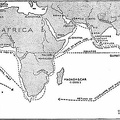One of the early influences of the art of printing was to bring to the notice of some restless minds the writings of Hero and Archimedes. In Hero's Pneumatics, published more than 120 years before Christ, he gives such a clear account of an invention of his own, in which the expansive force of steam was used to give and maintain motion, as to establish thoroughly his right to the basic invention of the steam engine. He described three apparatus that he devised. In one, the currents of air and aqueous vapor rising through a tube from a hollow sphere, containing water, under which a fire is burning, support a ball placed immediately above the tube, and make it seem to dance. In another apparatus, a hollow sphere into which steam has arisen from what we now call a boiler, is supported on a horizontal or vertical axis, and provided with tubes that protrude from the sphere, and are bent at right angles to the radius and also to the pivot. The inner ends of these tubes lie within the sphere, so that the steam passes from the sphere through the tubes. As soon as this happens, the sphere takes up a rapid rotation, that continue so long as the steam continues to escape from the nozzles of the tubes, which point rearwardly. A third apparatus was merely an elaboration of the second, in that the sphere was connected with an altar which supported a large drum on which were figures representing human beings. The fire being lighted, the sphere would soon begin to revolve, and with it the drum; and the figures on it would seem to dance around, above the altar. The invention was probably to impress the people with the idea that the priests were exerting supernatural power.
- Author
- Invention
The Master-key to Progress
Author: Bradley A. Fiske
Available from www.gutenberg.org
Published in 1921 - Posted on
- Wednesday 3 November 2021
- Dimensions
- 764*648
- Tags
- Albums
- Visits
- 414
- Downloads
- 24
 Download Photo
Download Photo





